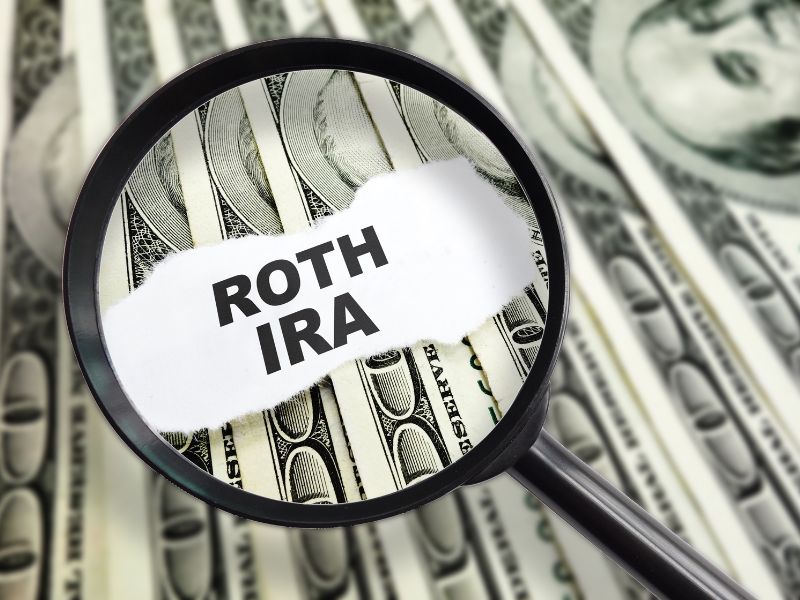Key takeaways:
- Roth IRA is a special retirement account where you put after-tax money in and get all future withdrawals without a penny tax.
- If you think your tax in retirement could be higher than now, this is definitely a great solution.
- If your income in 2023 exceeds $153,000 and you are single, you are not eligible for this plan. For married couples, the maximum is $228,000/year.
- The contribution limit can change over time. In 2023, the Roth limit increased to $6,500 (with an additional $1,000 for people aged 50 and older).
- You can register for a Roth account at almost all brokerage firms, banks, and investment companies.
What is Roth IRA?
An individual retirement account (IRA) is a special savings account for your retirement. You put money into it just like you would put money into a piggy bank. But here’s the twist: you already pay taxes on the money you put in. It’s like paying a small fee upfront.
Then, the magic happens when you retire. All the money you saved and any earnings it has made can be taken out of the account without paying any taxes. It’s like getting a bonus! The more money you put in and the more it grows, the bigger your bonus will be when you retire (assuming your retirement begins after the age of 59½ and your account has been active for at least five years).
Here’s an example to make it clearer: Let’s say you put $1,000 into your Roth account every year. Over time, that money grows and becomes $10,000 by the time you retire. Normally, you would have to pay taxes on that $10,000, but with a Roth account, you get to keep all $10,000 for yourself.
How does a Roth IRA work?
You can contribute money that you’ve already paid taxes on into a Roth IRA. It will then grow over time. When you retire and want to withdraw the money, you won’t have to pay any additional taxes on it.
Here are some ways to fund a Roth IRA:
- Regular contributions: You can make regular deposits into your Roth account from your earnings.
- Spousal IRA contributions: If your spouse doesn’t work, you can still contribute on their behalf.
- Rollover contributions: You can transfer funds from another retirement account, like a 401(k), into your Roth IRA.
- Conversions: You have the option to convert funds from a traditional IRA to a Roth IRA.
It’s important to note that regular contributions to a Roth IRA must be made in cash, including checks or money orders. Securities or property can not be used for contributions.
The Internal Revenue Service (IRS) sets limits on how much you can deposit into any type of IRA each year. These IRA limits may change at times. The contribution limits are the same for both traditional and Roth IRAs. Keep in mind that the maximum contribution applies to the total across all your IRAs, so you can’t contribute more than the set limit even if you have multiple accounts.

The advantages of Roth IRA
Understanding the advantages of this plan can help you make a conscious decision about whether it is the right retirement savings option for you. Let’s take a closer look at the positive aspects:
- No required minimum distributions: You’re not required to take out a minimum amount each year like with traditional IRAs or 401(k) accounts. You have the freedom to keep your money in the account for as long as you want without being forced to take withdrawals. This gives you more control over your savings.
- Tax-free inheritance: If you pass a Roth IRA to your heir, they can enjoy tax-free withdrawals as long as the account was held for at least five years at the time of your passing. It means they can receive the money without owing any taxes on it, which is a great benefit for them.
- Easy withdrawals: You can withdraw your initial contributions at any time without having to pay taxes or penalties. However, if you withdraw any earnings made on your investments, there may be taxes or penalties involved. It’s like having the flexibility to access your own contributions whenever you need them.
- Double dipping: You can contribute to a Roth IRA and an employer retirement account concurrently. It means you can leverage both types of account to boost your retirement savings.
- Flexible timing: You have the flexibility to choose when and how much you want to submit your contributions. You can contribute the full amount allowed at the beginning of the year, or you can spread out your contributions throughout the year. It’s all about finding a schedule that works best for you and your financial situation.
- No age limit to open: You can open a Roth account at any age, as long as you have earned income. This means you have the opportunity to start saving for retirement, regardless of your age. It’s never too late to begin securing your financial future.
Roth IRA rules and penalties
Don’t forget to stay ahead of the possible rules and penalties of this retirement plan. Here are some important rules about withdrawing money from a Roth IRA:
Withdrawing Rules:
- You are free to withdraw your contributions at any time without penalties or taxes, regardless of how long your account has been open. This is because you already paid income tax on that money before putting it into the account.
- The IRS always assumes that your original contributions come out first when you withdraw the money from your Roth account.
- If you are at least 59 1/2 years old and have held your account for at least five years, you can take out distributions, including any earnings, without having to pay federal taxes.
Withdrawing Penalties:
- If you want to withdraw investment earnings from your Roth account before you reach 59 1/2 years old, you may suffer from taxes and a possible penalty unless it is labeled as a “qualified withdrawal.”
- Examples of qualified withdrawals before age 59 1/2 include buying your first home, paying for education expenses, health insurance premiums while unemployed, disability-related expenses, or having a baby or adopting a child. Make sure you understand all the rules and exceptions for these qualified withdrawals.
Remember, it’s always a good idea to consult with a tax professional who can provide personalized guidance based on your specific situation. They can help you understand the rules and ensure you make informed decisions regarding your Roth IRA withdrawals. Claim your free consultation with our experts here!

Who is eligible for Roth IRA?
Anyone who has income can contribute to a Roth IRA, but there are requirements based on your filing status and income. The IRS sets Roth IRA contribution limits which can change over time. If your income is above a certain amount, you may not be able to contribute to a Roth IRA. Here are the income ranges for 2023:
- Married and filing jointly: Full contribution if modified adjusted gross income (MAGI) is less than $218,000; partial contribution if MAGI is between $218,000 and less than $228,000.
- Married, filing separately, and living with spouse: Full contribution if MAGI is $0; partial contribution if MAGI is less than $10,000.
- Single, head of household, or married filing separately without living with spouse: contribution if MAGI is less than $138,000; partial contribution if MAGI is between $138,000 and less than $153,000.
If your income falls within these ranges, you can contribute up to 100% of your compensation or the Roth contribution limit, whichever is less. If your income is within the phase-out range, you need to calculate the percentage you are allowed to contribute based on your income level.
What’s the difference between Roth and Traditional IRA?
Roth IRAs and traditional IRAs differ in how taxes are handled. With a Roth IRA, you enjoy tax-free withdrawals in retirement, while with a traditional IRA, you are provided a tax break on contributions. If you prefer immediate tax savings, go for a traditional IRA. If you want tax-free income later, choose a Roth IRA. Also, traditional IRAs have required minimum distributions every year starting at age 73, while Roth IRAs do not. Read more about the difference between Roth and Traditional IRA.
How to open a Roth IRA account?
Opening a Roth IRA account is an easy process. Here are the simple steps to follow:
- Check eligibility: Ensure you have earned income and meet the income limits set by the IRS.
- Choose a provider: Select a trusted financial institution that offers Roth IRA accounts, such as a bank, brokerage firm, or online platform.
- Complete the application: Fill out the application form given by the chosen provider, including personal information like your name, address, and Social Security number.
- Designate beneficiaries: Specify who will receive your Roth IRA assets if something happens to you. This ensures your savings go to the right people.
- Fund your account: Decide how much you want to contribute to your Roth IRA. You can contribute up to the maximum limit set by the IRS. Make your contribution through a cash deposit or transfer from another retirement account. Check out the contribution limit at Table 2-1. Effect of Modified AGI on Roth IRA Contribution.
- Choose investments: Select the investments you want your Roth IRA funds to be allocated towards. Common options include stocks, bonds, mutual funds, or ETFs.
- Monitor and manage: Keep an eye on your Roth IRA account and review your investments periodically. You can make adjustments as needed to align with your financial goals.

The average Roth IRA return and its rate
The average Roth IRA rate can vary. It depends on different things like the investments you choose and how the market performs. This account allows you to invest in things like stocks, bonds, and mutual funds. These investments can go up or down in value, so your return can change. It’s best to talk to a financial advisor for more specific information.

FAQ
1. Is It Better to Invest in a Roth IRA or a 401(k)?
The answer depends on your current situation and financial goals. A Roth IRA offers tax-free withdrawals in retirement, while a 401(k) provides upfront tax benefits. It may be beneficial to contribute to both if possible. Consider consulting a financial advisor to determine the best strategy for you.
2. Can I have a traditional IRA and Roth IRA at the same time?
Yes, you can have both a traditional IRA and a Roth IRA at the same time. However, there are annual contribution limits that apply across all your IRAs. It’s important to ensure your total contributions to both accounts do not exceed the maximum allowed by the IRS.
3. How Much Can I Put in My Roth IRA Monthly?
The maximum amount you can contribute depends on your age and income. As of 2021, individuals under 50 years old can contribute up to $6,000 per year or $500 per month. If you’re 50 or older, you can make an additional catch-up contribution of $1,000 per year.
4. Can I Set Up a Roth IRA for My Spouse Who Doesn’t Work?
Yes, you can set up a spousal account for your spouse who doesn’t work, as long as you meet certain requirements. You must have enough earned income to cover both your contributions and your spouse’s contributions to the Roth IRA. Seek advice from an expert to ensure eligibility and compliance.
5. What Should My Roth IRA Be Invested In?
Deciding Roth IRA what to invest in depends on your goals and tolerance for risk. You can choose from options like stocks, bonds, mutual funds, and ETFs. Diversifying your investments is necessary to manage risk. Receiving a comprehensive analysis from a financial planner is the best way to make wise moves.
In summary, a Roth IRA is a valuable savings tool that offers numerous benefits. By contributing after-tax money, you can enjoy tax-free withdrawals in retirement. This makes it an attractive option if you anticipate higher tax rates during retirement. If you have questions or need personalized guidance regarding retirement plans or any other financial matters, don’t hesitate to book a free consultation with our pros today!
>>>You may also like: Roth IRAs: Official Pros and Cons for Your Parents